One night in April, at the mines of São Domingos in Portugal, I listened to a pair of Common Barn Owls Tyto alba making display flights around two ramshackle old mine heads, one of which contained their nest. At the start of CD1-01, the high-pitched screech overhead comes from the female. I call it a ‘perennial screech’, a sound I hear all year round from both sexes. Immediately afterwards her mate starts ‘courtship screeching’ at a distance, gradually coming closer. This male-only sound belongs firmly in the breeding season. If Common Barn Owl has a ‘song’ then courtship screeching is it. Eventually the male arrives back at the nest, followed by the silent female. We hear a little thump as she lands, slightly to the right of the male.
CD1-01: Common Barn Owl Tyto alba Minas de São Domingos, Mértola, Portugal, 23:47, 13 April 2013. Courtship flight of a pair. The more isolated, high-pitched screeches are the female while the near-continuous, harsher screeching is the male. Background: Red-necked Nightjar Caprimulgus ruficollis, Little Owl Athene vidalii, Eurasian Eagle-Owl Bubo bubo and Common Nightingale Luscinia megarhynchos. 130413.MR.234752.00
For years, most of our encounters with barn owls took place by chance. While out recording other species, we would hear a few screeches in the distance which I now know to have been perennial screeches. I for one imagined that I was hearing mostly males, although I had no clear idea of how to tell them apart from females. I only really got to know courtship screeching when I started to target Common Barn Owls specifically.
Courtship screeching peaks during the weeks leading up to egg-laying. It has a hoarse timbre caused by modulations in the frequency of the sound at a rate of about 50-60 per second. Individual screeches rise smoothly in pitch but end fairly abruptly. Gaps between them may be of just a few seconds, making long series with hardly a break. Sometimes a male takes off on a ‘song flight’ and his stiff, shallow wingbeats make further ripples in the sound: five little surges per second in CD1-01. At other times the male stays perched. In CD1-02, we are at a nest on the edge of Rosmaninhal (‘the village of lavender’) in Portugal. After the third screech, the male takes off and screeches in flight for another minute.
CD1-02: Common Barn Owl Tyto alba Rosmaninhal, Idanha-a-Nova, Portugal, 21:45, 4 March 2010. Courtship screeches while perched near the nest, and then in flight. Background: Southern Tree Frog Hyla meridionalis and Little Owl Athene vidalii. 100304.MR.214545.01
Lone males are among the most fanatical courtship screechers; they screech to attract females (Bühler & Epple 1980). After mating, they use the same sound to defend the female from rivals. Neighbours sometimes courtship screech in long-distance duels. Although predominantly a male sound, Mebs & Scherzinger (2004) claim that either sex can advertise availability with screeching if necessary.
In CD1-03, we are in traditional montado near Lisbon, again in Portugal, with Cork Oaks Quercus suber and Holm Oaks Q ilex scattered through meadows reserved for fighting bulls. It is late March and a thunderstorm has just taken two hours to pass. Finally, the scattered trees and lush meadow grass stop rustling and the air loses its turbulence. Bit by bit as the acoustic opens up, various creatures reoccupy their niches. Crickets take possession of higher frequencies. In the lower range, fast croaks of European Tree Frogs Hyla arborea and a few slower ones of Southern Tree Frogs H meridionalis catch my attention. At centre stage, two Common Barn Owls exchange perennial screeches, one near and one far, for reasons known only to themselves.
CD1-03: Common Barn Owl Tyto alba Pancas, Benavente, Portugal, 31 March 2012. Perennial screeches of two different individuals. Background: European Tree Frog Hyla arborea and Southern Tree Frog H meridionalis. 120331.MR.231814.31
Perennial screeching is the Common Barn Owl sound we hear most often throughout the year. Rising slowly in pitch, the screech grows in volume for one to two seconds and typically ends abruptly with a pronounced upward inflection. The timbre is a concentrated hissing, like an espresso machine with the steam on. Individual barn owls often seem to have a fairly distinctive signature based on the amount of hiss versus whistle, how strongly their screech rises in pitch, and how abruptly it ends. Barn owls give perennial screeches one at a time at long but fairly regular intervals. They may fly quite far during the gaps, so when a loud screech at close range catches our attention, the next one may seem surprisingly faint and distant. Less often, either sex may also produce perennial screeches when perched at the nest.
In CD1-04, a male of the subspecies erlangeri is flying along a flat-bottomed valley in the Jabal Samhan range in southern Oman, giving a perennial screech about once every 40-50 seconds. This well-vegetated wadi is a popular picnic spot during the day. In April, the grass is dry but three months later it will catch the north end of the Indian Ocean monsoon. Although this is Arabia, the habitat is not so dramatically different from that of the bird’s European relatives, containing grassland, a few trees and some water. The neighbours, however, could hardly be more different. Every few seconds, an Arabian Scops Owl Otus pamelae goes prrr and an Arabian Eagle-Owl Bubo milesi moans languidly in the distance. An Arabian Wolf Canis lupus arabs begins to howl. Other members of its pack join in, eventually making such a din that we are hardly able to hear the barn owl’s second screech. The scratchy sounds at close range are footsteps of a scrawny cow on gravel, curious about me and apparently oblivious to the wolves
CD1-04: Commonly Barn Owl Tyto alba Wadi Darbat, Dhofar, Oman, 21:30, 18 April 2010. Perennial screeches in flight. The barn owls of Arabia belong to subspecies erlangeri. Background: Arabian Wolf Canis lupus arabs, Arabian Scops Owl Otus pamelae and Arabian Eagle-Owl Bubo milesi. 100418.MR.213018.12
Perennial screeching is virtually the only barn owl sound that I hear during the autumn. At my home near Sintra in Portugal, I like to record nocturnal migration of passerines on suitable nights, leaving my microphones out for the quieter hours from midnight to dawn. Barely a session goes by without me recording a couple of perennial screeches.
Despite hearing perennial screeching so often, I still have no clear idea what it ‘means’. All I can say is that it is some kind of long-distance advertisement, perhaps with an aggressive or at least assertive tone. For a long time I believed this was a territorial call (Sorace 1987, Siverio et al 1999), but barn owls are not territorial in the usual sense. Instead, they occupy a huge ‘home range’, only defending a small area around the nest or perhaps just their mate (Barn Owl Trust 2012).
Occasionally, it can be more difficult to distinguish between perennial and courtship screeching, especially in males. Perhaps during the breeding season, male perennial screeches become more like courtship screeches. CD1-05 is an example of such ambiguity, recorded in the Netherlands. A slightly gargling screech on my right sounds long and modulated, but more concentrated than a typical courtship screech. The owl is in no hurry and passes invisibly in front of me; 38 seconds later it screeches a little further away on my left. The third screech is surprisingly distant.
CD1-05: Common Barn Owl Tyto alba De Weerribben, Overijssel, Netherlands, 26 April 2008. Ambiguous screeches of a male. The breeding population in the Netherlands belongs to subspecies guttata. Background: Marsh Frog Pelophylax ridibundus, Common Snipe Gallinago gallinago and Sedge Warbler Acrocephalus schoenobaenus. 080426.MR.005550.11
The ghost of long extinct barn owls lingers on in these ancient screeches. Several contemporary species seem to share very similar calls, so their shared ancestors probably sounded little different. Barn owls belong to the oldest surviving lineage of owls, the Tytonidae. They diverged from the Strigidae, including all the other owls in this book, in the late Eocene. The oldest known barn owl is Necrobyas rossignoli, dating from around 37 Ma or million years ago (Mourer-Chauviré 1987, Escarguel et al 1997). The first of the genus Tyto appeared more than 20 million years later, possibly in Southeast Asia and New Guinea where the highest diversity of Tyto occurs today (Wink et al 2009). Originally, these were birds of humid, tropical forest, and although several have subsequently evolved to live in open habitats, they are still absent from the coldest and most arid places. Like most tropical birds, barn owls are basically sedentary.
During the 20th century, ‘the barn owl’ was seen as a classic example of a cosmopolitan species, having a wide range of subspecies on six continents and an array of oceanic islands. Variation in appearance is indeed extensive, expressed in overall size, the relative proportions of bill, tarsus and toes, the amount of feathering on the tarsus, the degree of dark-redness and the number and size of black spots. With DNA studies showing that there are in fact quite ancient divisions within the complex (eg, Wink et al 2009, Nijman & Aliabadian 2013), the taxonomic arrangement has started to change. A deep divide separates Common Barn Owl on the one hand, including birds from Europe, Africa and most populations in Asia, from another branch that includes Eastern Barn Owls
T delicatula from southern Asia, Australasia, parts of Indonesia and some Pacific Islands. During a warmer period in the past, an early representative of this eastern branch made it to Alaska and founded a lineage that spread all the way to Patagonia. It includes American Barn Owl T furcata and Ashy-faced Owl
T glaucops, an endemic of Hispaniola (Wink & Heidrich 1999).
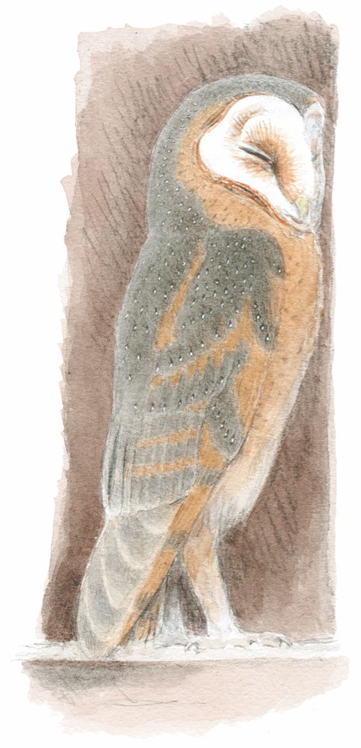
Håkan Delin
In the Western Palearctic, taxonomists usually recognise five continental and three oceanic barn owl taxa. The five traditional continental taxa are nominate alba of the Mediterranean and western Europe, guttata from central and eastern Europe, ernesti from Corsica and Sardinia, erlangeri of the Arabian peninsula and adjacent areas (populations in North Africa have been variously assigned to alba, erlangeri or ernesti) and, at the southern border of the WP, affinis of sub-Saharan Africa. The three Atlantic island taxa are gracilirostris of the Eastern Canary Islands (‘Slender-billed Barn Owl’), schmitzi of Madeira, the Desertas and Porto Santo (‘Madeira Barn Owl’), and detorta from the Cape Verde Islands (‘Cape Verde Barn Owl’). Up to now, only the continental taxa have been included in phylogenetic studies. Of those, the most genetically distinct is affinis (eg, Aliabadian et al 2012). The oceanic taxa differ in many ways from the continental ones, and I have chosen to treat each one separately.
Recognising two basic types of screeches makes it much easier to compare the sounds of different barn owl taxa. Screeches of alba and guttata are to all intents and purposes identical, while erlangeri differs only very slightly if at all. By contrast, there are dramatic differences between Common and American Barn Owls. American has much shorter perennial screeches, typically less than a second long, and in a wide range of recordings, I have never heard American giving anything remotely like a courtship screech. Gerrit Vyn is the author of an excellent CD on North American owls (2006). When I sent him an example of Common Barn Owl courtship screeches, he confirmed he knew nothing similar from American. This not only supports separating the two species but also the two kinds of screeches.
At the same time, American Barn Owl has a prominent flight call that is completely absent in Common Barn Owl. It was Gerrit who recorded the metallic clicking sound in CD1-06, which he calls the ‘kleak-kleak call’ (Vyn 2006). Unpaired males use it most often (Gerrit Vyn pers comm), so it must have an important role in mate attraction. Marti et al (2005) reported that males kleak in the vicinity of the nest, soon after leaving the daytime roost, and when approaching with food deliveries. Several other Tyto species have similar calls (eg, African Grass Owl T capensis, Eastern Grass Owl T longimembris and Australian Masked Owl T novaehollandiae). So rather than being an American invention, it seems that Common stopped using this call and replaced it with courtship screeching.
CD1-06: American Barn Owl Tyto furcata, Oahe Dam, Stanley County, South Dakota, USA, 23:30, 13 April 2007. Kleak-kleak calls and bill-snapping during the courtship period. Background: Northern Pintail Anas acuta. Gerrit Vyn & The Macaulay Library at the Cornell Lab of Ornithology
Purring is a sound related to courtship screeching but used by both sexes. A shrill grating or reeling, it is usually delivered from a perch. Sequences of purring typically lack a tidy structure and often sound rather chaotic. I like to think of purring as an excited, unisex modification of courtship screeching, reserved for close male-female interactions. In CD1-07, we are back at the mines of São Domingos. Peals of Nossa Senhora de Fátima ring out from a church in the neighbouring village, followed by several short bursts of purring. Bühler & Epple (1980) described purring in a variety of contexts, some involving aggression, while in others it seemed to be a contact call between pair members. Like courtship screeching, purring is a call that belongs to the breeding season. I have never heard it at any other time.
CD1-07: Common Barn Owl Tyto alba Minas de São Domingos, Mértola, Portugal, 22:58, 11 March 2012. Purring of a male and a female. Background: Southern Tree Frog Hyla meridionalis and Iberian Green Frog Pelophylax perezi. 120311.MR.225842.01
The rivalry scream is a particularly impressive call possibly derived from the perennial screech. A descending scream in a high, often pure-sounding voice, it is usually delivered without modulations. To those of a fertile imagination, the rivalry scream can be a heart-stopper, even at a distance. If the example in CD1-08 fails to impress, fast forward and listen to a much closer example from a Slender-billed Barn Owl (CD1- 15). To other male barn owls, the rivalry scream is provocative rather than scary. On a few occasions, I have been listening to courtship screeching of a male perched at close range when a distant male screamed. The nearer bird would immediately increase its screech rate, and sometimes take off to make itself more audible.
CD1-08: Common Barn Owl Tyto alba Azrou, Western Middle Atlas, Morocco, 00:07, 24 June 2010. Rivalry screams at a distance. 100624.AB.000700.32
CD1-15: Slender-billed Barn Owl Tyto gracilirostris Vega de Rio Palmas, Fuerteventura, Canary Islands, 21:57, 28 January 2010. Rivalry screams in flight, becoming more distant each time. 100128.MR.215700.31
Although our priority has been to illustrate sounds that anyone may hear from a distance, occasionally we have captured more intimate, close-range sounds. In CD1-09 a male is giving a long sequence of subdued courtship screeches; he started nearly 40 minutes earlier. Every now and then the female purrs quietly, or gives a louder call that seems to combine purring with a perennial screech. In between louder calls she makes a very quiet, high-pitched purring (eg, at 0:06 and 0:17). This is her copulation call. She uses it both to solicit sex and during the act (Bühler & Epple 1980). A microphone inside the nest would probably record this call often, but from a respectful distance I have rarely heard it.
CD1-09: Common Barn Owl Tyto alba Rosmaninhal, Idanha-a-Nova, Portugal, 22:21, 3 March 2010. Male courtship screeching with louder purring and extremely quiet copulation calls of a female. Background: Little Owl Athene vidalii. 100303.MR.222124.30
Once a pair of barn owls has fertilised and laid their clutch, all goes quiet, and you could easily spend an hour or two in the vicinity of a nest without noticing them. The female incubates her clutch for a month, during which time she is entirely dependent on her mate. As he flies towards the nest to deliver food to her, he typically gives a few short, quiet ‘chirrups’, often with a rising, questioning intonation. He also chirrups at the nest when he wants to start an interaction. Perhaps chirruping helps to pacify the female. In CD1-10 there are five chirrups at the start of the recording. The male switches to food-offering calls immediately after he arrives at the nest. These are fast chattering or clucking sounds, which the female will also use a few weeks later when feeding the young. The female purrs quietly when he arrives, but soon begs for more food with a series of very quiet soliciting calls.
CD1-10: Common Barn Owl Tyto alba Rosmaninhal, Idanha-a-Nova, Portugal, 23:51, 6 April 2010. Chirrup and food-offering calls of male, with purring and soliciting calls of a female. Background: Little Owl Athene vidalii. 100406.MR.235125.01
From about five weeks before egg-laying until the young are large enough not to be brooded, the female uses soliciting calls whenever the male is at the nest. In CD1-11, she is easy to hear because the nest is a tree cavity with a large opening. The microphone is on the ground, only 3 m below. The recording starts with a male chirrup, the first of several. This immediately triggers some loud soliciting calls (as well as one or two very quiet begging calls of a tiny juvenile). The male enters the cavity at 0:27, at which point his chirrups turn into purring. The female’s soliciting calls change too, becoming more like copulation calls. By the end of the recording, they revert to the way they were at the start.
CD1-11: Common Barn Owl Tyto alba Pancas, Benavente, Portugal, 00:29, 1 March 2013. Chirrup calls of a male, soliciting calls and possibly copulation calls of a female, and very quiet begging calls of a tiny juvenile. Background: Tawny Owl Strix aluco. 130301.MR.002948.01
Vocal activity at the nest increases gradually as the young grow up. At first their chirping calls are too faint to attract much attention. The adult female responds by offering more comfort while the male ignores them completely (Bühler & Epple 1980). From the very first day, however, the owlets also use a begging call, which both adults respond to. The begging call becomes much more noticeable after the female stops brooding and starts hunting along with the male, typically when the youngest owlet is about 10 days old (Bunn et al 1982). I often find nests thanks to begging calls, since they carry a long distance. Imagine how well the adult barn owls must be able to hear them. Evolution did not leave this to chance. The frequency of the sound fits neatly into the barn owl’s most sensitive hearing range (Konishi 1973).
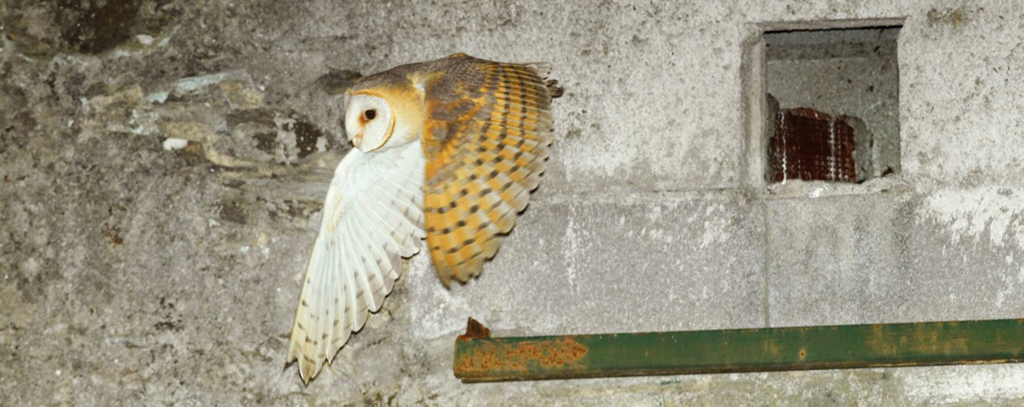
Common Barn Owl Tyto alba, presumed male, Rosmaninhal, Idanha-a-Nova, Portugal, 21 April 2012 (Dick Forsman). Possibly same bird as in CD1-02 & CD1-09 to 10.
Roulin et al (2000) found that in the absence of adults, siblings negotiate who will get the next food item, signalling levels of hunger to one another to avoid having to fight. In CD1-12, several fledglings are begging under a bridge. The hungriest two are calling at the start, then at 0:12 an adult arrives with food and they all call. The young start to negotiate who’s next and the calling begins to calm down, until just two are calling. Then the adult sees me and flies out from under the bridge, perching on a post just 2 m away. It gives a series of mobbing screams that intimidate me, silence the young for a little while, and probably also warn the other parent some distance away. The last scream is right above my head, strongly modulated by hovering wingbeats. Time for me to leave. Fledged owlets can also give mobbing screams when threatened, similar to the adult version but harsher.
CD1-12: Common Barn Owl Tyto alba Rosmaninhal, Idanha-a-Nova, Portugal, 00:56, 14 May 2012. Juvenile begging calls and adult mobbing screams. Background: Long- eared Owl Asio otus (juveniles) and Common Nightingale Luscinia megarhynchos. 120514.MR.005632.10
The hardiest of all Common Barn Owls are those belonging to the dark-plumaged subspecies guttata that now live in central and eastern Europe. According to Voous (1950) their ancestors survived the last ice age in a refuge somewhere near the Black Sea, while the ancestors of pale-plumaged nominate alba retreated to a refuge in the Iberian peninsula. When the continent began to warm up again, the owls moved north with their small mammal prey. Barn owls normally occupy lower altitudes, up to 250-300 m in Britain and 1300 m in Spain (Alegre et al 1989), corresponding to about 40 days of winter snow (Taylor 1994). Those guttata breeding north of the Balkan mountains and the eastern Alps are unlikely to have got there by spreading across high ground. Instead, the valleys of the Danube and other rivers must have been the corridors along which they arrived. Meanwhile, alba spread from Spain into France and on into Britain and Ireland, which were not yet islands. If Voous was right, alba and guttata eventually met somewhere in central Europe. Apparently lacking strong enough ‘isolating mechanisms’, they started to interbreed over a wide area.
The difference between the subspecies alba and guttata is essentially one of plumage with two independent features accounting for the variation, dark redness being one and black spots on the underparts being the other. From Portugal in the southwest to the Baltic states in the northeast, there is a gradual or clinal increase in plumage redness (Roulin 2004, Antoniazza et al 2011). While mixing of previously separate populations may partly account for this, there is also a striking link between redness and diet.
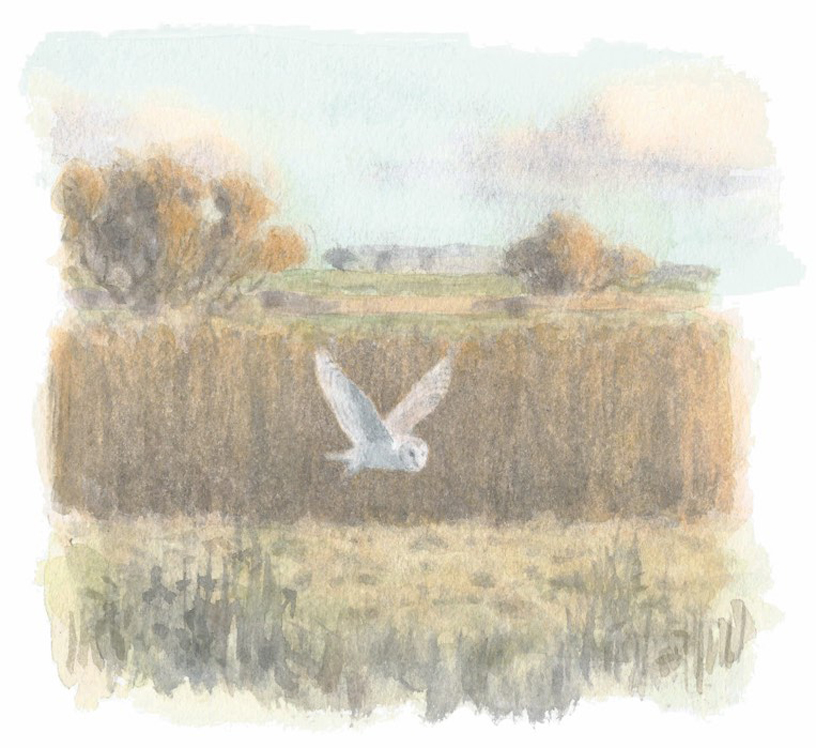
Håkan Delin
According to Roulin (2004), plumage redness increases from southwest to northeast across Europe because it favours the barn owls’ ability to catch certain important prey species, which vary in their relative abundance. Redder barn owls in the north eat more Common Voles Microtus arvalis, harvest mice Micromys, long-tailed shrews Sorex and water shrews Neomys, while paler ones in the south eat more Wood Mice Apodemus sylvaticus, house mice Mus and white-toothed shrews Crocidura. This also applies at a local scale. In Switzerland, where dark red and pale individuals occur sympatrically, plumage is linked to prey choice. More recently, Dreiss et al (2011) found that this only holds for females, and noted a link with habitat. Redder females prefer to breed in habitats with more arable fields, while paler ones prefer to breed in territories with more trees.
If the subspecies alba and guttata were once clearly distinguishable, geographically separate populations, now they may be just two extremes of appearance. Any subspecies border that we draw will be arbitrary. In Israel, Charter et al (2012) found the same relationship between redness and prey species in subspecies erlangeri. In this case no geographical cline was involved. So the merging of different populations is not necessary for significant local adaptations of this nature to evolve. Beyond the Middle East, no two authors seem to agree where erlangeri ends and alba begins. Genetically, there appears to be little if any difference between alba, erlangeri and guttata (Aliabadian et al 2013). My analysis of their sounds also failed to find any clear differences between these three. Arguably, then, erlangeri and guttata are meaningless names, which can be chucked into the taxonomic dustbin.
As for ernesti, some treat it as a Corso-Sardinian endemic subspecies while others include similar barn owls from North Africa and elsewhere in the Mediterranean region (eg, König et al 2008). Pellegrino et al (2014) recently discovered that little owls Athene from Sardinia are genetically distinct, begging the question whether this is also true of Corso-Sardinian barn owls. Several endemic barn owls did live on Mediterranean islands in the past, especially on islands around Italy, and some were very distinctive indeed.
Gargano currently forms the spur on Italy’s boot, a peninsula embedded in its southeast coast. When the Miocene ended 5.33 million years ago and the Mediterranean basin suddenly filled up after a dry period, Gargano became an island. Of the mammals that found themselves trapped there, only one – an otter – was carnivorous. With reduced predation the evolution of smaller mammals went into overdrive, the most obvious result of which was that many grew larger. There were giant dormice, huge pikas, monster hamsters and supersized hairy hedgehogs. During the day, two endemic species of Garganoaetus eagles preyed on them. At night it was the turn of the barn owls, of which there were three on Gargano (Ballman 1973). Compared to Common Barn Owl occurring there now, the smallest, still inadequately described species was only slightly larger, the medium sized T robusta was about 60% larger, while T gigantea was more than twice its size. In fact, gigantea was larger and much heavier than a Eurasian Eagle-Owl B bubo.
Another giant barn owl lived on Sicily during the Mid-Pleistocene, T mourerchauvineae, and it was as large as robusta. Sicily also lacked mammalian predators at the time. The Sicilian Barn Owl fed primarily on a dormouse the size of a rabbit but also on other endemic dormice and shrews, and a variety of birds (Pavia 2004). It was contemporary with a dwarf elephant called Elephas falconeri that stood only 90 cm high. Conceivably, a large female owl might have killed the occasional runt elephant calf, although this is pure speculation on my part!
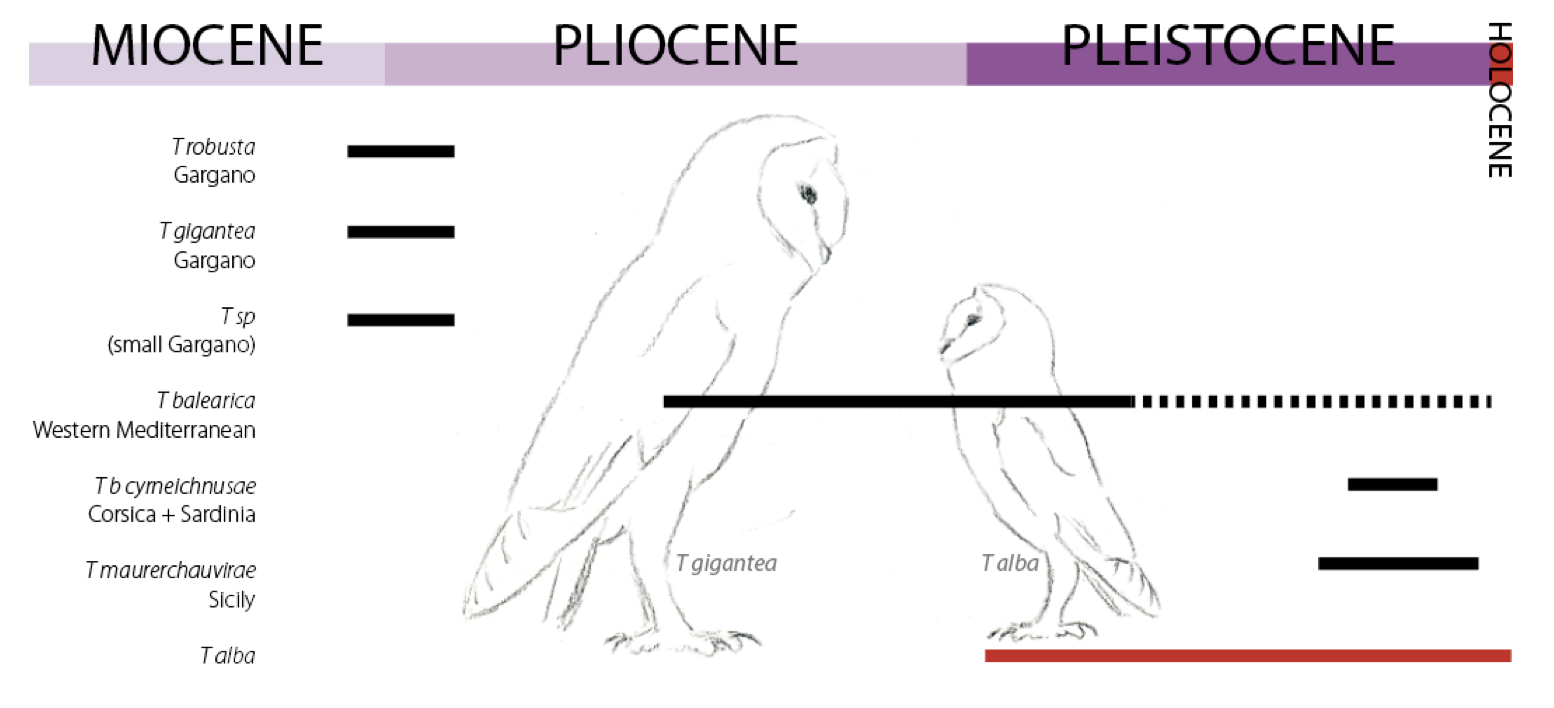
In the western Mediterranean, T balearica, about one and a half times the size of Common Barn Owl, preyed on large rodents (Mourer-Chauviré et al 1980). The oldest currently accepted finds are from the continent, while later ones come from islands such as Mallorca and Menorca (Mourer-Chauviré & Sanchez Marco 1988, Mourer-Chauviré & Geraads 2010). On Corsica and Sardinia, the endemic subspecies cyrneichnusae survived until at least 350,000 years ago. Florit & Alcover (1987) detected signs of balearica’s continued presence on Mallorca in the Late Pleistocene, and it may have survived until humans arrived in the Balearic Islands less than 2000 years ago.
In Macaronesia, three endemic, insular barn owls survive to this day. None is especially large, but all hunt rather unusual prey, or did until humans arrived a few centuries ago. For the sake of argument we will treat each one as a species, but let’s be clear; their sounds differ only subtly and none has been the subject of a thorough genetic study.
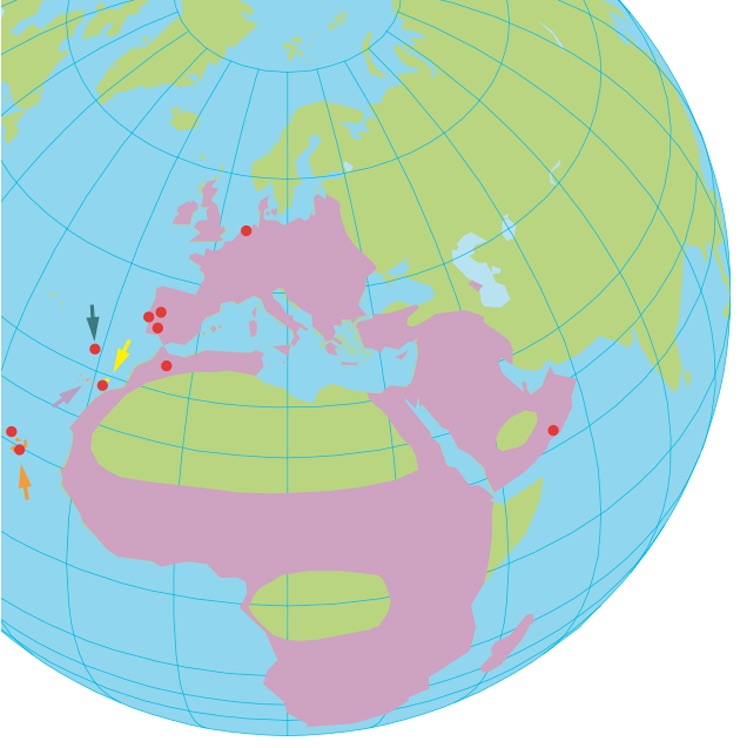
Approximate breeding distribution of Common Barn Owl Tyto alba (pink) and breeding islands of Slender-billed Barn Owl T gracilirostris (yellow) arrow, Madeira Barn Owl T schmitzi (green) arrow and Cape Verde Barn Owl T detorta (orange) arrow. Recording locations indicated by red dots.
